2024 Science Highlights
Time Domain Studies and Fundamental Physics
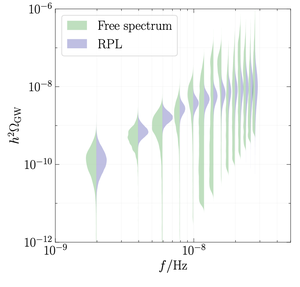
The GBT, with the support of the VLA, has made core contributions to the North American Nanohertz Observatory for Gravitational Waves (NANOGrav) strong evidence for the stochastic gravitational wave background from merging supermassive black holes throughout the cosmos. This discovery represents a watershed event in modern physics. The 15 year data have now been used to set a more refined limit on the power spectrum of the gravitational waves, beyond a simple amplitude and power-law spectral index, by allowing for a running logarithmic change in the spectral index with frequency. The results show no evidence that the spectral index changes with frequency. The results are used to constrain models of primordial gravitational waves from cosmic inflation during the first 10-32 s of the Universe.
Left: NANOgrav power-spectrum of the gravitational wave background for a spectrally free model (independent frequency bins), and a constrained running power-law spectral index (NANOGrav consortium 2024 arXiv:2408.10166).

NANOgrav constraints (blue) with other cosmological measurements, on the power-law spectral index and running of the power-law index, for primordial gravitational waves from cosmic inflation (NANOGrav consortium 2024 arXiv:2408.10166)
The GBT has performed its first searches for quantum chromodynamic (QCD) axions that represent a primary candidate for dark matter. QCD axions might be converted into photons in regions of very strong magnetic field, such as around strongly magnetized neutron stars. The interaction between an axion miniclump and a neutron star might lead to a very narrow band and transient radio signal.
Right: NANOgrav constraints (blue) with other cosmological measurements, on the power-law spectral index and running of the powerlaw index, for primordial GW from cosmic inflation (NANOGrav consortium 2024 arXiv:2408.10166).
 The GBT is an ideal facility for such a search, given its sensitivity and spectral capabilities. The VErsatile GBT Astronomical Spectrometer (VEGAS) was used at X-band at the GBT to search for such lines from the center of the Andromeda galaxy, plus a control region well off the galaxy. Extensive methodology was developed to avoid spurious signals. The measurements were sensitive to axions with masses between 33 and 42 micro-eV. The null result from the short observations was consistent with the current model for axion dark matter, although the constraints are not strong given the limited observing time. However, the noise limited spectra are a key technical demonstration, and a guide to future experiments over wide areas in the Milky Way or longer observations of Andromeda, possibly with a dedicated radio telescope.
The GBT is an ideal facility for such a search, given its sensitivity and spectral capabilities. The VErsatile GBT Astronomical Spectrometer (VEGAS) was used at X-band at the GBT to search for such lines from the center of the Andromeda galaxy, plus a control region well off the galaxy. Extensive methodology was developed to avoid spurious signals. The measurements were sensitive to axions with masses between 33 and 42 micro-eV. The null result from the short observations was consistent with the current model for axion dark matter, although the constraints are not strong given the limited observing time. However, the noise limited spectra are a key technical demonstration, and a guide to future experiments over wide areas in the Milky Way or longer observations of Andromeda, possibly with a dedicated radio telescope.
Left: Image showing the regions searched for Axionic dark matter in Andromeda (red dots). Right: noise limited GBT spectra for different time records, cleaned of RFI, at 8 GHz (Walters et al. arXiv:2407:13060).
ALMA has mapped the polarized emission and Faraday rotation measures across the radio jet in M87 at 2” resolution at 90 GHz. The core has a large RM of 4.5x104 rad m-2, and time variability suggests the magnetized plasma causing the rotation measures may be due to an ionized wind from the Active Galactic Nuclei (AGN) within a few thousand gravitational radii of the black hole. The RM along the jet suggest a helical configuration for the external magnetic field on kpc-scales.
Left: Total intensity (contours) and fractional polarization (color), plus E-field vectors for M87 from ALMA at 86GHz. Right: Faraday rotation measures across the jet and core (Peng et al. 2024, arXiv:2409.12028).
Solar System and Planetary Science
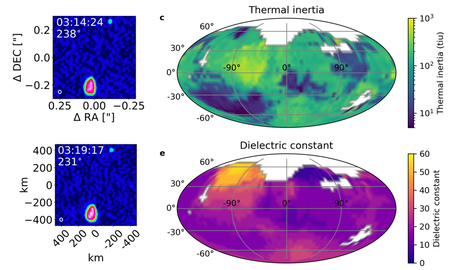 ALMA and the VLA have been used to determine the abundance and distribution of metals on the surfaces of the asteroid Kalliope and its moon Linus, with observations at 1.3, 9, and 20 mm down to 25 mas resolution (30 km on the surface). Kalliope is an M-type asteroid, with a high concentration of metals, such as iron. The mean thermal inertia of Kalliope is about 116 J m-2 s-0.5 K-1, and the surface radio emissivity about 0.6. Kalliope’s millimeter wavelength emission is suppressed compared to its centimeter wavelength emission, and it is also depolarized. The radio emissivity for Linus is higher, indicating a less metal-rich surface composition. Spatial structure in the emissivity is observed on Kalliope, with a region in the northern hemisphere with a high dielectric constant, suggesting enhanced metal content. These results are consistent with a scenario in which Linus formed from reaggregated ejecta from an impact onto a differentiated Kalliope (differentiation meaning elemental separation during a melting phase driven by radioactive elements), leaving Kalliope with a higher and more structured surface metal distribution than Linus. The low emissivity and lack of polarization suggest a regolith composition where iron is in the form of metallic grains and constitutes ∼25% of the surface composition.
ALMA and the VLA have been used to determine the abundance and distribution of metals on the surfaces of the asteroid Kalliope and its moon Linus, with observations at 1.3, 9, and 20 mm down to 25 mas resolution (30 km on the surface). Kalliope is an M-type asteroid, with a high concentration of metals, such as iron. The mean thermal inertia of Kalliope is about 116 J m-2 s-0.5 K-1, and the surface radio emissivity about 0.6. Kalliope’s millimeter wavelength emission is suppressed compared to its centimeter wavelength emission, and it is also depolarized. The radio emissivity for Linus is higher, indicating a less metal-rich surface composition. Spatial structure in the emissivity is observed on Kalliope, with a region in the northern hemisphere with a high dielectric constant, suggesting enhanced metal content. These results are consistent with a scenario in which Linus formed from reaggregated ejecta from an impact onto a differentiated Kalliope (differentiation meaning elemental separation during a melting phase driven by radioactive elements), leaving Kalliope with a higher and more structured surface metal distribution than Linus. The low emissivity and lack of polarization suggest a regolith composition where iron is in the form of metallic grains and constitutes ∼25% of the surface composition.
Left: images of one rotational/orbital phase of the asteroid Kalliope and its moon Linus at 1.3mm with ALMA at 30 km (25mas) resolution, with units of arcsec (upper) and km (lower). Right: derived physical surface quantities for the regolith in a full surface projection (de Kleer et al. 2024, arXiv:2409:12364).
The VLA and IRAM telescopes have been used to study the centimeter and millimeter brightness distribution across Saturn’s synchronous moon Iapetus. In the optical, 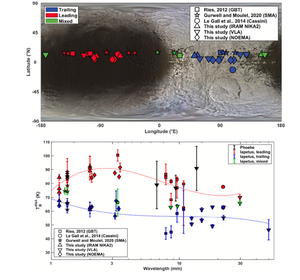 Iapetus has the most dramatic difference of albedo for two hemispheres of any object in the Solar system, with the albedo on the leading hemisphere (direction of orbit), much lower than on the trailing hemisphere. This optical albedo difference is thought to be due to an accumulation of dark material on the leading hemisphere, while the trailing hemisphere remains mostly icy and bright. The centimeter and millimeter observations are sensitive to thermal emission from the subsurface, but they also show a major difference between leading and trailing hemispheres in radio emissivity, or brightness temperature. The results imply complex variations in structure and/or composition with depth on the leading side, while the trailing side emissivity is low at all observed frequencies, indicating efficient scattering processes on subsurface structures, as observed on Saturn’s other icy moons. These radio observations also involve Saturn’s retrograde moon Phoebe. Iapetus’ prograde orbit is within the inner edge of the large but faint outermost ‘Phoebe ring’ around Saturn, thought to be formed by material ejected by meteoric impacts on the surface of Phoebe. The radio observations show a high radio emissivity for the surface material of Phoebe, similar to the leading side of Iapetus, supporting the theory that Phoebe is the source of the optically dark material accumulated on the leading hemisphere of Iapetus.
Iapetus has the most dramatic difference of albedo for two hemispheres of any object in the Solar system, with the albedo on the leading hemisphere (direction of orbit), much lower than on the trailing hemisphere. This optical albedo difference is thought to be due to an accumulation of dark material on the leading hemisphere, while the trailing hemisphere remains mostly icy and bright. The centimeter and millimeter observations are sensitive to thermal emission from the subsurface, but they also show a major difference between leading and trailing hemispheres in radio emissivity, or brightness temperature. The results imply complex variations in structure and/or composition with depth on the leading side, while the trailing side emissivity is low at all observed frequencies, indicating efficient scattering processes on subsurface structures, as observed on Saturn’s other icy moons. These radio observations also involve Saturn’s retrograde moon Phoebe. Iapetus’ prograde orbit is within the inner edge of the large but faint outermost ‘Phoebe ring’ around Saturn, thought to be formed by material ejected by meteoric impacts on the surface of Phoebe. The radio observations show a high radio emissivity for the surface material of Phoebe, similar to the leading side of Iapetus, supporting the theory that Phoebe is the source of the optically dark material accumulated on the leading hemisphere of Iapetus.
Right: optical image of Saturn’s synchronous moon Iapetus indicating the measurement regions of radio brightness temperature. Bottom: the brightness temperature spectrum in these regions (Bonnefoy et al. 2024, Icarus 411, 115950), showing the large difference in radio emissivity of the leading (red) vs trailing (blue) hemispheres.
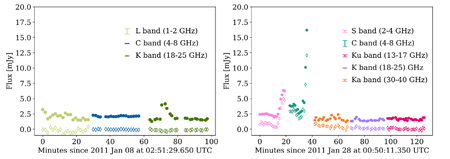 Magnetic activity on M-dwarf stars has become topical in the search for life in other planetary systems, since many M-dwarfs host potentially habitable planets, but strong stellar storms may inhibit development of life. The VLA and ALMA have observed the nearby (2.7 pc) binary M-dwarf system BL and UV Ceti, from 1 GHz to 100 GHz. The stars have similar masses, spectral types, and rapid rotation rates, but UV Ceti has much stronger magnetic activity, showing radio flares similar to Solar coronal flares, auroral-like emission analogous to planetary magnetospheres, and slowly varying persistent emission. These phenomena suggest both small-scale field reconnection activity, and larger scale auroral currents in a global magnetic field. The persistent emission mechanism may parallel that seen for gyrosynchrotron emission from Jupiter’s radiation belts, corresponding to electrons trapped in a large scale radiation belt associated with the star.
Magnetic activity on M-dwarf stars has become topical in the search for life in other planetary systems, since many M-dwarfs host potentially habitable planets, but strong stellar storms may inhibit development of life. The VLA and ALMA have observed the nearby (2.7 pc) binary M-dwarf system BL and UV Ceti, from 1 GHz to 100 GHz. The stars have similar masses, spectral types, and rapid rotation rates, but UV Ceti has much stronger magnetic activity, showing radio flares similar to Solar coronal flares, auroral-like emission analogous to planetary magnetospheres, and slowly varying persistent emission. These phenomena suggest both small-scale field reconnection activity, and larger scale auroral currents in a global magnetic field. The persistent emission mechanism may parallel that seen for gyrosynchrotron emission from Jupiter’s radiation belts, corresponding to electrons trapped in a large scale radiation belt associated with the star.
Left: VLA light curves for UV Ceti on two days. Stokes I is shown with filled circles and Stokes V with open diamonds (Plant et al. 2024, 2406.17280). Flaring, time varying, and persistent emission can be seen.
Star and Planet Formation and Evolution, and the Search for Life
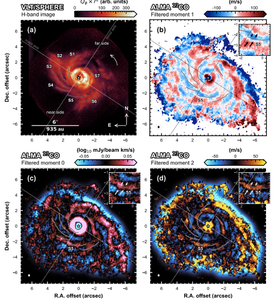 Most models of planet formation entail growth from accretion from small pebbles to rocks to planetesimals in a dusty disk. But the possibility exists for planets to form from large collapsing clouds in a disk with spiral arms, if the disk is more than 10% the stellar mass and gravitationally unstable to non-Keplerian dynamics. ALMA observations of the CO emission from the disk around the Class II protostar and disk, AB Aurigae (2.4 M⊙ and 3.5 Myr old), shows such an unstable spiral disk of gas and dust, with a disk to stellar mass ratio of about 1/3. This unstable gas disk suggests that there may be multiple channels toward planet formation in protoplanetary disks, including direct collapse of a massive gas fragment.
Most models of planet formation entail growth from accretion from small pebbles to rocks to planetesimals in a dusty disk. But the possibility exists for planets to form from large collapsing clouds in a disk with spiral arms, if the disk is more than 10% the stellar mass and gravitationally unstable to non-Keplerian dynamics. ALMA observations of the CO emission from the disk around the Class II protostar and disk, AB Aurigae (2.4 M⊙ and 3.5 Myr old), shows such an unstable spiral disk of gas and dust, with a disk to stellar mass ratio of about 1/3. This unstable gas disk suggests that there may be multiple channels toward planet formation in protoplanetary disks, including direct collapse of a massive gas fragment.
Left: ALMA and VLT images of the gas and dust in the protoplanetary disk around AB Aurigea, showing dynamical evidence for a massive disk and spiral structure that may enhance monolithinc massive planet formation (Speedie et al. 2024 Nature 633, 58). The CO column density, mean velocity, and velocity dispersion are shown.
Complex molecular chemistry, including large organic molecules, has become a key field in astronomy, on the path toward understanding the development of life in the Universe. One challenge for such studies is accurate knowledge of rest frame frequencies of transitions from these molecules. The GBT has been used, in concert with high resolution (2 kHz) laboratory measurements, to obtain an accurate spectrum of propynal (HCCCHO) emission from the well-studied molecular cloud, TMC-1. These measurements also provide a greatly improved knowledge of the rest frequencies of the complex spectrum of propynal. The new data imply a propynal column density of 7x1012 cm-2, five times higher than previous studies, with a surprisingly low excitation temperature of 3 K. The results highlight the synergy between laboratory and astronomical chemistry, and emphasize that accurate spectral catalogs are essential to the success of modern astronomical facilities, and will only become more important as the next generation of facilities come online.
Right: GBT spectra of propynal (HCCCHO) emission transitions from TMC-1 (black trace), plus model fitting based on new laboratory measurements combined with the GBT spectra (Remijian et al. 2024 arXiv:2409.16435).
The Protostellar Outflows at the EarliesT Stages (POETS) large program at the VLBA is designed to understand the enigmatic mechanisms behind jet launching from forming massive stars via measurements of water maser proper motions in a sample of 37 young stellar objects. A detailed study of the YSO 21078+5211 shows a maser 3D velocity field consistent with a magnetohydrodynamic (MHD) model of a wind created in an accretion disk associated with the forming star, with the jet launch radius of about 10 au. The jet both collimates and accelerates to 60 km/s out to 50 au. At 100 au distance, the masers trace a slower shock front possibly driven by magnetic pressure.
Left: Water maser 3D velocities in IRAS 21078+5211 from the VLBA. Right: 3D model of the MHD disk-wind in this source, with maser spots overlaid on MHD streamlines predicted by simulations of a jet around a forming massive star (Moscadelli et al. 2024 arXiv:2408.11968).
The VLA, ALMA, and the JWST have teamed-up for an in-depth study of star formation in the luminous infrared Seyfert galaxy NGC 7469, at a resolution of ~100 pc, in particular in the starburst ring that dominates star formation in this AGN host galaxy. Observations include 1.2 mm dust continuum, CO2-1 line, VLA 22 GHz continuum, and starlight and polycyclic aromatic hydrocarbon (PAH) emission with the JWST. A star formation rate of 11.5 M⊙/yr and molecular gas mass of 6.4x109 M⊙ are derived. The star formation distribution along the ring is traced closely by the 22 GHz, 1.3 mm, and 7.7 µm PAH emission. The gas mass to star formation rate relationship in NGC 7469 is found to be intermediate between starburst galaxies and galaxies hosting an active nucleus.
Right: VLA 22 GHz continuum (color and white contours) plus ALMA 1.3mm continuum contours (black) of the IR-luminous Seyfert galaxy NGC 7469. Right: JWST F770W image, with same black ALMA contours (Zanchettin et al. 2024, arXiv:2406.07901).
Galaxies and Galaxy Formation
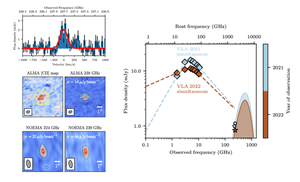 The most distant known radio blazar has been discovered in the VLASS, J0410-0139 at z = 7. Broadband VLA radio observations show that this source is a highly time variable, GHz-peaked spectrum radio AGN, characteristic of blazars, a conclusion supported by X-ray observations. ALMA and the Northern Extended Millimeter Array (NOEMA) observations of the [CII] 158mm emission provide a very accurate redshift of 6.9964, and a star formation rate of 50 M⊙ yr-1. The [CII] dynamics imply a host galaxy mass of 4.6x109 M⊙. The black hole mass to host galaxy mass ratio is 0.16, which is larger than is seen for the relationship in nearby galaxies, suggesting earlier growth of the supermassive black hole relative to the host galaxy.
The most distant known radio blazar has been discovered in the VLASS, J0410-0139 at z = 7. Broadband VLA radio observations show that this source is a highly time variable, GHz-peaked spectrum radio AGN, characteristic of blazars, a conclusion supported by X-ray observations. ALMA and the Northern Extended Millimeter Array (NOEMA) observations of the [CII] 158mm emission provide a very accurate redshift of 6.9964, and a star formation rate of 50 M⊙ yr-1. The [CII] dynamics imply a host galaxy mass of 4.6x109 M⊙. The black hole mass to host galaxy mass ratio is 0.16, which is larger than is seen for the relationship in nearby galaxies, suggesting earlier growth of the supermassive black hole relative to the host galaxy.
Left: ALMA and NOEMA observations of the [CII] 158mm emission and mm continuum from the most distant known radio Blazar at z = 7, identified in the VLASS. Right: the radio spectrum and time variability verifying the blazar nature of the source (Banados et al. 2024), including variability and a GHz-peaked spectrum.
The [CII] Resolved ISm in STar-forming galaxies with ALMA (CRISTAL) large program with ALMA observed the gas ([CII]), dust, and stellar distribution (with Hubble Space Telescope, or HST), in a sample of z = 4 to 6 galaxies. The derived gas distributions range in size from 0.5 to 3.5 kpc, with an average value of 1.9 kpc, and the gas appears to be more extended than the dust emission and the stars by factors of 2.9 and 1.5, respectively. The [CII] emission can be explained by photodissociation regions driven by star formation, plus a possible contribution from more diffuse neutral atomic gas. The effect of mergers further inflates the [C II] spatial distributions.
Right: ALMA [CII] 158mm observations of z = 4 to 6 galaxies in the CRISTAL large program (contours), with the HST images (Ikeda et al. 2024).
 A gravitationally lensed z = 8.3 galaxy was observed with ALMA and the JWST, resolving the three primary star forming regions in the galaxy on sub-kiloparsec scales, in a possibly merging galaxy system. This gas-rich galaxy shows comparable star formation efficiency to cosmic noon galaxies (z ~ 2), and the emission line ratios of the galaxy indicate an evolved interstellar medium, again similar to z ∼ 2 star-forming galaxies, with possible evidence for ionization from an active galactic nucleus. Comparison of the thermal dust emission with the rest frame UV and optical emission, shows major dust obscuration of the dominant star forming regions, such that the UV only reveals a trace amount of the star formation activity in the galaxy.
A gravitationally lensed z = 8.3 galaxy was observed with ALMA and the JWST, resolving the three primary star forming regions in the galaxy on sub-kiloparsec scales, in a possibly merging galaxy system. This gas-rich galaxy shows comparable star formation efficiency to cosmic noon galaxies (z ~ 2), and the emission line ratios of the galaxy indicate an evolved interstellar medium, again similar to z ∼ 2 star-forming galaxies, with possible evidence for ionization from an active galactic nucleus. Comparison of the thermal dust emission with the rest frame UV and optical emission, shows major dust obscuration of the dominant star forming regions, such that the UV only reveals a trace amount of the star formation activity in the galaxy.
Left: Images of the z = 8.3 lensed galaxy MACS0416-Y1: (a) ALMA 353 GHz dust continuum emission; (b) JWST near-IR F277W image with the three stellar components of the galaxy labeled, with ALMA contours; (c) JWST RGB image of rest-frame UV; (d) JWST rest frame optical image (Harshan et al. 2024).
The VLA Sky Survey (VLASS), VLA Low-band Ionosphere and Transient Experiment (VLITE), and ALMA, working with the JWST and other telescopes, have identified the highest redshift, heavily obscured, radio-loud (RL) active galactic nucleus (AGN) to date at z = 7.7 in the Cosmic Evolution Survey (COSMOS) field. The AGN is seen only at radio through (possibly) mid-IR wavelengths, implying extreme obscuration, with NH > 1043 cm-2. A massive stellar host galaxy is seen, with a stellar mass of ~ 1012 M⊙. The AGN bolometric luminosity for the growing supermassive black hole is of order 1047 erg/s. This source represents the farthest-known highly obscured radio loud AGN.
Right: Images of the z = 7.7 AGN galaxy with the JWST, ALMA, and the VLA, and the UV to meter wavelength spectrum. This is the most distant radio loud AGN identified to date (Lambrides et al. 2024).
 Perhaps the most exciting result from the JWST has been the robust detection of galaxies well into the epoch of reionization, at z = 10 to 15, corresponding to the very first generation of star formation in the Universe, within a few hundred Myr of the Big Bang. ALMA provides crucial follow-up observations, through the study of the interstellar medium in these first galaxies, with observations of the rest-frame far infrared fine structure lines. The new record holder for the most distant ALMA galaxy detection is [OIII] 88mm line emission from JADES-GS-z14-0. The ALMA detection yields a spectroscopic redshift of z = 14.1793±0.0007, improving the precision on the JWST redshift by a factor of 180! The star forming galaxy is at the lower end the local L[OIII]88 – star formation rate relation. No dust continuum emission from GS-z14 is detected, implying an upper limit on the dust-to-stellar mass ratio of 0.002, consistent with dust production from supernovae. GS-z14 is surprisingly metal-enriched (Z ∼ 0.05 − 0.2Zo). The detection of a bright oxygen line in GS-z14 thus reinforces the notion that galaxies in the early Universe undergo rapid evolution and InterStellar Medium (ISM) enrichment through active star formation, just 300 Myr after the Big Bang.
Perhaps the most exciting result from the JWST has been the robust detection of galaxies well into the epoch of reionization, at z = 10 to 15, corresponding to the very first generation of star formation in the Universe, within a few hundred Myr of the Big Bang. ALMA provides crucial follow-up observations, through the study of the interstellar medium in these first galaxies, with observations of the rest-frame far infrared fine structure lines. The new record holder for the most distant ALMA galaxy detection is [OIII] 88mm line emission from JADES-GS-z14-0. The ALMA detection yields a spectroscopic redshift of z = 14.1793±0.0007, improving the precision on the JWST redshift by a factor of 180! The star forming galaxy is at the lower end the local L[OIII]88 – star formation rate relation. No dust continuum emission from GS-z14 is detected, implying an upper limit on the dust-to-stellar mass ratio of 0.002, consistent with dust production from supernovae. GS-z14 is surprisingly metal-enriched (Z ∼ 0.05 − 0.2Zo). The detection of a bright oxygen line in GS-z14 thus reinforces the notion that galaxies in the early Universe undergo rapid evolution and InterStellar Medium (ISM) enrichment through active star formation, just 300 Myr after the Big Bang.
Right: The ALMA [OIII] 88mm detection of a z = 14.18 galaxy. Left shows the [OIII] contours on the JWST near-IR image. Right shows the ALMA spectrum (Schouws et al. 2024 arXiv:2409.20549).

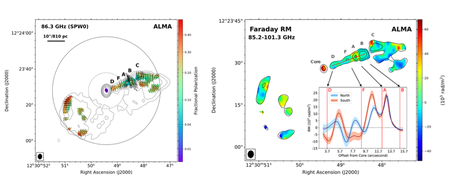
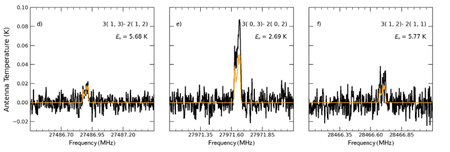


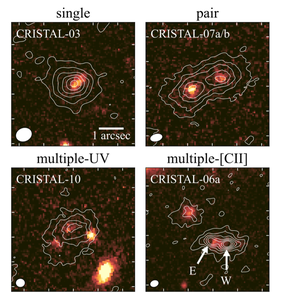




Connect with NRAO